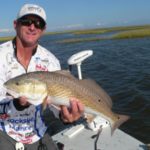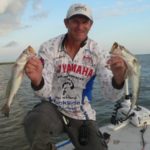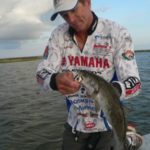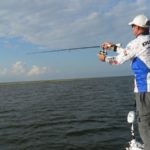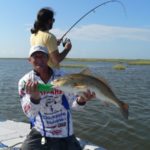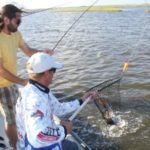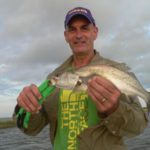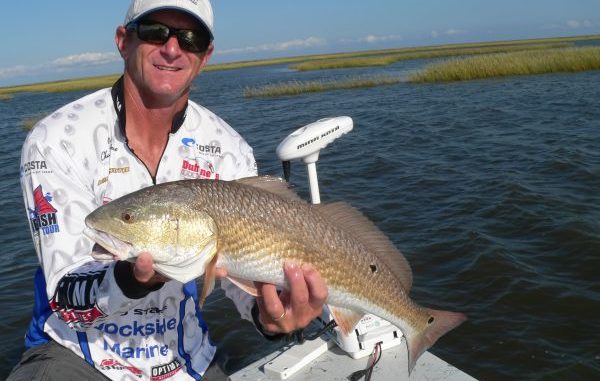
Fishing was inconsistent out of Delacroix this summer, but that all changes this month when trout move into the marshes and the redfish go wild. Learn how to make quick work of your limits.
Imagine my surprise to find long-time Golden Meadow charter Capt. Chad Dufrene fishing out of Delacroix Island — not just occasionally, but full time.
Dufrene has put down roots, built a camp and now calls Delacroix his home port.
What led to this drastic move? It’s all about the fishing, he said.
“It’s been a long time coming,” Dufrene explained. “The fishing situation down around Golden Meadow became intolerable. We have a bad situation down there, with landowners gating off the canals and bayous and refusing access to the public. Some have put up guards along with the gates and actually have hired patrols to keep boaters out of the waterways. I don’t know how they get away with gating off tidal waters, but they do it, and anglers are finding it more and more difficult to fish in the marsh because of it.
“I got so sick of having to look over my shoulder all the time when I fish, so I moved. Now I pray that craziness doesn’t start over here.”
It had probably been five years or so since I fished with Dufrene — who has won 10 boats in IFA Redfish Tour, the old HT Redfish Series (now called the Elite Series) and the FLW Redfish Series — so I gave him a call and set up a trip.
We met at his dock on Delacroix Island, and I brought my soon-to-be son-in-law Nick Underwood and his recently retired U.S. Marshall Service dad Mitch. The three of us piled into Chad’s 25-foot bay boat and headed down Bayou Terre aux Boeufs toward our destination.
The Delacroix area suffered this summer from lower-than-normal water levels due to strong, persistent west winds. It made trout hard to find, but at least the redfish action stayed consistent.
Today our goal was to hit a few of Delacroix’s November hotspots and see if the trout were there and in a cooperative mood — and then we’d turn our attention to some redfish.
“The trout show up first in the big outer bays,” Dufrene said. “Bay Lafourche, Oak River Bay, Bakers Bay — all those big fringe bays are productive, usually starting around mid-September, and into October. Even Black Bay is good, well into October. You can run out there now and still catch some fish at the structures, islands, wellheads and reefs. The action does get spotty in late fall, but there are plenty of nice specks and redfish out there.
“But the good news is (that) by November we just won’t have to run that far to find fish. This is when they start showing up in real good numbers and decent sizes at the mid-range lakes and bays.”
His targets include Bayou Long at Bayou Batola, the west shoreline of Lake Batola, the southeast end of Lake Batola near the Pencil Canal and the southwest end of Pointe Fienne.
I watched the Lowrance GPS on the center console read out speeds of well over 50 mph as Dufrene piloted the big Majek bay boat to our first stop, an area near a point in one of the bigger fringe bays.
“We’ll drift and try all around here, and if we bump into some trout I’ll stick the Power-Pole,” he said.
For bait, Dufrene said live shrimp are always the best bet, but by November plastics should produce just as well, and sometimes they’ll yield even bigger fish.
“In September and early October you almost have to fish with live bait. The fish are still transitioning, they’re scattered and it takes live shrimp to get the bite,” he explained. “Once the trout start settling into a late October through November pattern, though, you can use plastics very successfully.
“But I’ll still carry some live shrimp if I can get them, just for insurance.”
When it comes to plastics, Dufrene likes Matrix Shads in either lemonhead or shrimp creole color, fished about 2 ½ feet under a cork.
Dufrene produces his own cork.
“I got tired of using those expensive, flimsy popping corks that don’t hold up, so I started making my own,” he said. “I bought a wire bender and started experimenting with lengths of wire, weights, swivels, beads, etc., and finally settled on the pattern I’m using now.
“They are heavy duty, and you can cast them a mile.”
And no, he does not offer them for sale. They are exclusively for his clients’ and his personal use, he said.
Dufrene is a strong believer in stealth mode fishing. In other words, fish as quietly as you can so you don’t spook the fish in the shallow Delacroix waters.
That means he does a lot of drifting, using the trolling motor just enough to steer the boat.
“I’ve fished the tournament trail for years, and from standing on a platform and watching fish with my own eyes, I can attest that they spook easily,” Dufrene said. “If you want to catch fish in the shallow marsh, fish as quietly as possible.
“No slamming hatches closed or making other noises. And no running the outboard.”
So we snuck around points to fish current lines for specks, and we managed to pick off a few decent fish.
Every good fish we caught caused Dufrene to set the Power-Pole down, and we tried to sit on the action. But the trout just weren’t schooled up, so we’d only manage one or two fish before we had to resume drifting.
“This is what you have to do in the fall: drift and cast all around the boat,” Dufrene said. “When somebody catches a decent fish, set the Power-Pole or Cajun anchor and see if you can put some numbers in the boat.
‘When the action stops, resume the drift. I often go back and drift the same area several times until I just don’t get any more bites.”
We pecked and moved, pecked and moved, accumulating a nice bunch of specks in the ice chest in the process.
But a powerful east wind steadily increased all morning, and soon it was blowing a blustery 20 knots. So Dufrene suggested we spend the rest of the morning chasing redfish, which are less affected by the winds.
“There are several other mid-range bays and lakes I’ll also target this month,” Dufrene said. “Skippy Lake is a well-known hotspot, as is Four Horse Lake, Little Lake and Bay Andrew. You can drift them for trout, and then move closer to the shoreline and fish points and coves right up against the bank, using live or market shrimp or Berkley Gulps under a cork.”
The first thing we did was shorten our lines hanging below the corks as Dufrene trolled us to within casting distance of the shoreline.
“I fish a little deeper for trout — probably 2 ½ to 3 feet under a cork, and sometimes as deep as 4 feet, depending on the weather and the depth of the water,” he said. “But you have to shorten up to 18 inches to a maximum 24 inches under a cork to fish the shoreline for reds.”
We still had a tank full of live shrimp, so we used them. But Dufrene said dead shrimp are just as productive for reds, and Gulps also become productive once fall weather actually settles in.
Dufrene trolled a section of broken marsh islands and set the Power-Pole down, prevented the boat from swinging in the wind by casting a Cajun anchor off the bow. That positioned us so the shoreline was reachable by long casts.
And in about a minute we had a hefty redfish on the line.
It would be one of many that morning.
“The east winds blow water in and makes it high in the marsh, so the reds will be up against the grass foraging for food,” Dufrene said. “The key today will be getting your bait as close to the bank as you can so they can find it.”
So we did, and they did.
We kept moving from one section of broken marsh to another, always following the same procedure: stop, anchor, cast, catch, move.
That rhythm continued until we were one fish shy of our four-man limit and forced to quit by a rapidly approaching rainstorm.
“The only other thing I’ll add is that, as it cools down later in the fall or if we get some real early cold weather, you’ll want to fish a bit deeper,” Dufrene said. “I’ll start targeting the Twin Pipelines at the intersection of Lake John, and fish current/tide lines. And I’ll also fish the Twin Pipeline at the Sister Bayou intersection, and the Twin Pipeline at Little False River.”
He also tagged the mouth of Lake Fausan at the Spyder Canal, the Spyder at Oak River and Oak River itself near any of the intersections with the various lakes.
“The key to success is to fish a moving tide and fishing the bottom with live shrimp, or try the Matrix Shad on a 3/8-ounce jighead,” Dufrene said.
Editor’s note: Capt. Chad Dufrene can be reached at 985-637-6357 or online at dufrenesguideservice.com.
